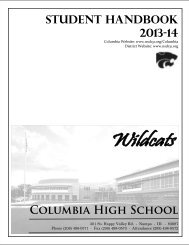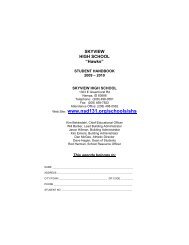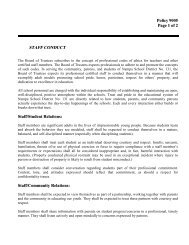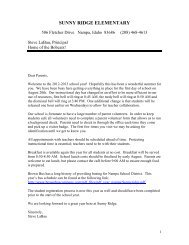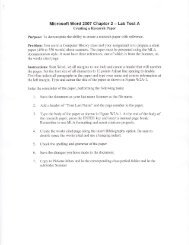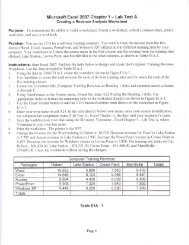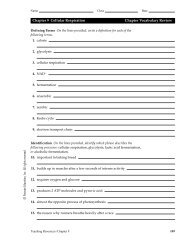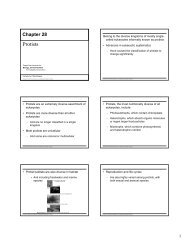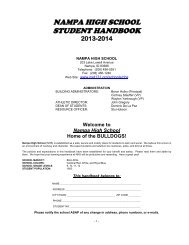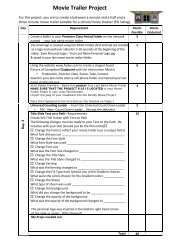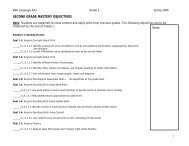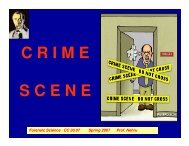Endeavor Elementary School Handbook 2012-13 - NSD Main
Endeavor Elementary School Handbook 2012-13 - NSD Main
Endeavor Elementary School Handbook 2012-13 - NSD Main
Create successful ePaper yourself
Turn your PDF publications into a flip-book with our unique Google optimized e-Paper software.
Nampa <strong>School</strong> District <strong>13</strong>1<br />
<strong>Endeavor</strong> <strong>Elementary</strong> <strong>School</strong><br />
<strong>Handbook</strong> <strong>2012</strong>-<strong>13</strong><br />
2824 E. Victory Road<br />
Nampa, ID 83687<br />
468-4629<br />
www.nsd<strong>13</strong>1.org/endeavor<br />
Thank you for choosing our school!<br />
Our Vision: We provide the foundation so that all students will develop a personal vision, opening their own doors<br />
of opportunity for meaningful and productive lives.
<strong>Endeavor</strong> <strong>Elementary</strong> <strong>School</strong> Policies<br />
(Please also review our district policies for elementary school students on our website at:<br />
www.nsd<strong>13</strong>1.org/endeavor.)<br />
“ Our mission is to promote and model a culture of<br />
respect, love, responsibility and high academic expectations in<br />
order to cultivate a passion for life long learning in our <strong>Endeavor</strong><br />
Community.”<br />
In order to achieve the above mission, we have the following expectations:<br />
Hallway Expectations<br />
• Be quiet<br />
• Keep hands, feet and objects to self<br />
• Keep hands away from walls<br />
• Keep lines straight; move to the right side of the hallway in single file or double lines.<br />
• Walk, don’t run in the halls.<br />
Hall Passes are required of all students when they are out of their assigned class. Students without hall<br />
passes will be escorted back to class.<br />
Restroom Expectations<br />
• Respect the privacy of others<br />
• Respect school property<br />
• Leave the restroom as clean or cleaner than you found it<br />
• Wash your hands<br />
• Put paper, etc. in trash can<br />
• Leave the area as soon as you are done<br />
Cafeteria Expectations<br />
• Walk at all times<br />
• Speak quietly and calmly<br />
• Keep hands, feet, body and objects to yourself, do not touch anything<br />
• Don’t share your food<br />
• Clean up after yourself<br />
• Don’t throw food<br />
• Return tray and any garbage to proper place<br />
Library Expectations<br />
• keep the library clean; no gum, candy or pop allowed inside<br />
• Respect others’ rights to a quiet place to study; use quiet voices<br />
• Walk at all times<br />
• Do not remove books from the library without checking them out first<br />
Assembly and Concert Expectations<br />
• Be respectful, courteous, and quiet during assemblies or concerts<br />
• Sit in your designated area with your teacher<br />
• Applaud and respond appropriately to the speaker or group performing<br />
1
Playground expectations<br />
• Be respectful<br />
• Take turns<br />
• Follow all game rules as given by our P.E. teacher<br />
• Take care of all equipment<br />
• Running on grass area only<br />
• Bark, rocks, and snow stay on the ground<br />
• Jump ropes- use them appropriately; no “horse” or “helicopter”<br />
• When the bell rings stop what you are doing, bring in equipment, pick up jackets and line up<br />
facing forward (no hand games)<br />
• Do not bully others or fight<br />
• Hats or headwear may be worn for inclement weather or for medical reasons but are<br />
inappropriate inside the school building.<br />
• For the safety of our students we discourage flip flops<br />
Our Schedule<br />
<strong>School</strong> is Open …………………..8:25 am<br />
SCHOOL STARTS ……………….. 8:50 am<br />
Lunch times: 11:00-12:40 Contact your student’s teacher for detailed lunch times<br />
Dismissal………………………….3:40 p.m.<br />
Birthdays<br />
Birthday celebrations are celebrated differently from classroom to classroom. Please check with your<br />
child’s teacher to see how she/he would like this handled. To celebrate your child’s birthday, you may<br />
bring or send a store bought treat. Room mothers may contact parents to provide treats for class<br />
parties. Notice: Due to hurt feelings, party invitations of any kind will NOT be distributed at school.<br />
Flowers or balloons will not be delivered to the classroom until the end of the school day and are NOT<br />
allowed on the bus.<br />
Before/after school expectations<br />
We are concerned about student safety and do not want children on the playground unsupervised.<br />
Students may come on the playground after 8:25 a.m. Students are expected to enter the building from<br />
the playground, not the front doors of the school. Students are expected to exit the building and school<br />
grounds by the established exit route and not linger on the school grounds after school is released.<br />
• Bikes, scooters, and skateboards are to be walked off the grounds.<br />
• Bus pick-up is on the left hand side of the building as you face the building.<br />
• Student pick-up is in the front (curved side) of the school.<br />
• For your child’s safety, students should use the designated crosswalks.<br />
• Students who walk home are expected to go directly home and to respect the property to and<br />
from home.<br />
Student Pick-Up Procedures<br />
Students being picked up are dismissed at 3:40 pm. Parents picking up students are to pull up in front of<br />
the building in one line, along the curb. Stay in your car. Students will wait for cars at the left end of the<br />
building. As cars reach the far left end of the building, the appropriate child/children will be placed in the<br />
car and the family may head home. Stay in your car. As the cars leave, other cars must move up, in the<br />
2
single file line along the sidewalk until they reach the far left end and the students are picked up. NEVER<br />
double park. Always stay in the car to keep the line moving. If you need to exit the car, please park in a<br />
designated spot in the parking lot, not along the curbs or behind other parked cars.<br />
Checking Children out of Class or off the Bus or Bus Line<br />
If you need to pick up your child during the school day, please follow the procedures below. For safety<br />
purposes, students will not be released to any person other than parent/guardian without written<br />
authorization from the parent/guardian.<br />
• Sign student out on the checkout sheet at reception desk. Please DO NOT go directly to the<br />
student’s classroom.<br />
• Provide identification (driver’s license) establishing your relationship with the child.<br />
• If your name does not appear on the enrollment form, you may not pick up the child without<br />
written authorization from the parent/guardian.<br />
• Additional measures may be necessary to establish permission to pick up a student. We<br />
appreciate your patience with our safety measures. As we become familiar with parents’ faces,<br />
identification may not be necessary each time for checkout.<br />
• If you wish to check your child out when he/she is in a bus line or on the bus, please check out<br />
the student with the office and obtain a pass to identify yourself to the person on duty. Please<br />
call the office before 2:30 pm with messages for your child so we can relay the information<br />
before dismissal.<br />
Extra-curricular Activities<br />
<strong>Endeavor</strong> <strong>Elementary</strong> will offer a variety of extra-curricular events for students to participate in such as<br />
boys and girls basketball (grades 4-5), co-ed volleyball (grade 5), speed jump roping (grades 4-5), cup<br />
stacking (grades 4-5), girls/boys track (grades 4-5), and music concerts.<br />
Food, Drink & Gum<br />
Food and drink are allowed only in the cafeteria unless approved by a teacher or administrator. Gum is<br />
not allowed in the building, on the playground or on the bus without administrative approval. Students<br />
are discouraged from bringing soda pop to school with their lunch.<br />
Library Books<br />
Library books are checked out to students and may be taken home. Students are responsible to pay for<br />
lost and/or damaged books. A library checkout policy paper must be signed and returned before your<br />
child is permitted to check out books from the school library.<br />
Lost and Found<br />
Please mark your child’s property (lunch boxes, backpacks, coats, hats and gloves) with their name. Check<br />
the lost and found periodically for missing items. Items that are left in the Lost and Found are donated to<br />
local charities at the end of each quarter.<br />
Parent Teacher Association<br />
All parents and staff are invited to join our Parent Teacher Organization at <strong>Endeavor</strong> <strong>Elementary</strong>. The PTO<br />
meets informally once a month to discuss school improvement, parent and student issues and concerns,<br />
and school/community events. Please be involved as we work together to provide the best learning<br />
experience for every child.<br />
3
Student Transfer/Reassignments:<br />
The following policy applies to all transfer and reassignment requests:<br />
• Parents must submit a written request to the Principal stating the reasons for the transfer<br />
request.<br />
• Our school must receive the written request at least 2 weeks prior to the end of the grading<br />
period.<br />
• Transfer requests received with less than two weeks left in the grading period will be delayed<br />
until the end of the next grading period<br />
• Transfers and reassignments will only be made at the end of the 1 st and 2 nd nine weeks<br />
• Parents must demonstrate/document that they have conferenced with the teacher (twice) in an<br />
attempt to resolve concerns<br />
• Parents will be given written notification as to whether or not their request for<br />
transfer/reassignment has been approved before the beginning of the next grading period<br />
Volunteers<br />
We welcome and encourage you to volunteer. Volunteers can help in a variety of ways including listening<br />
to a child read, tutoring, updating bulletin boards, serving on our site improvement team, supervising field<br />
trips or helping with the many other tasks. Please contact your child’s teacher, any staff member or the<br />
PTO President if you can help. A volunteer ID and sign in book will be found in the school’s front office.<br />
Academic Integrity<br />
We expect the highest academic integrity from our students. Should a student not adhere to this<br />
expectation at <strong>Endeavor</strong>, it is up to the discretion of the classroom teacher and/or administrator to<br />
determine the appropriate consequence(s) based on the specific situation.<br />
4
Parent Request Procedures<br />
In most cases, it is not necessary for parents to request a teacher for their child for<br />
the next school year. This is done by the teacher at the child’s current grade level. Many<br />
factors are considered in placement, including teacher input, peer relations, learning<br />
styles, teaching styles, behavior and special needs of students. The classroom must also<br />
be balanced. In order to keep classrooms balanced we will allow for parent requests<br />
to make up no more than 30% of each classroom.<br />
Parents may still request a teacher if there are additional factors that need to be<br />
considered in placement. Parents may write a letter outlining the specific reasons for<br />
their request or they may complete a Teacher Request Form. These forms are available<br />
from the school office. There will be a deadline in May announced each year for turning<br />
in requests before teachers create new class lists.<br />
All requests will be given serious consideration. However, the requested placement is<br />
not guaranteed. This information will be used to determine the best placement for all<br />
students. It is our desire to work with parents and to do our very best for each child.<br />
Once the deadline has passed and class lists are assigned, parent requests for a change<br />
of class assignment will be evaluated on an individual basis by the Building<br />
Administrator or Principal and the teachers affected by the change. If a parent requests a<br />
teacher after the May deadline, there is no guarantee that it will be honored.
Revised June <strong>2012</strong><br />
Attendance/Absences/Tardies<br />
Our district’s elementary policies <strong>2012</strong>‐<strong>13</strong><br />
(Please also review our school’s unique policies.)<br />
Students should be in school every day to be successful. Students who are frequently absent from school<br />
often fall behind academically and can struggle. Nampa school board policy states:<br />
“All children of compulsory attendance ages (7‐16) are required to attend school. Attendance and<br />
punctuality are important elements of the educational process for all students. Therefore, all enrolled K‐<br />
12 students are expected to be in school 100% of the time classes are in session, unless they are<br />
participating in school‐related activities otherwise excused by <strong>School</strong> Board Policy or Idaho State Law.”<br />
If your child will be absent from school, please call the school before 9 a.m. If we don’t hear from you, we<br />
are obligated to verify the absence. If you are having trouble getting your child to school on time, please<br />
contact us so we can identify resources that may help.<br />
If your child has missed 5 days, the school will contact you; 7 days will result in a letter or phone call to<br />
schedule a conference with you; and if your child misses 10 days of school, the student will be referred to<br />
the <strong>School</strong> Resource Officer to identify the next steps on truancy. Excessive tardies will be addressed by<br />
the administration as well.<br />
Students will have two days for every excused day missed to make up work. It is the student’s<br />
responsibility to request make‐up work. When a student has had an excused absence for three<br />
consecutive days, the parent may request make‐up work be sent to the office to pick up. Requested work<br />
will be available by end of the next school day.<br />
Bicycles, Scooters, Skateboards, Rollerblades<br />
Students are welcome to use bicycles, scooters, skateboards or rollerblades to ride to school. Once the<br />
student arrives at school the bicycles, scooters, skateboards or rollerblades need to be immediately<br />
secured on bike racks or in designated locations. For their safety and to reduce wear and tear on school<br />
facilities, students wearing heelies (rollerskating tennis shoes) will be asked to lower or remove the<br />
wheels. We cannot replace lost or stolen items, so please use a lock.<br />
Bullying<br />
Our school is committed to providing a safe learning environment for students. This includes identifying<br />
and taking steps to prevent bullying among our students. Bullying occurs when a child is exposed,<br />
repeatedly and over time, to negative actions on the part of one or more children. Bullies want the victims<br />
to feel: hurt, sad, mad, scared, or embarrassed. Bullying behaviors include, but are not limited to:<br />
<br />
<br />
<br />
<br />
Physical: kicking, shoving, hair pulling, hitting, slapping, biting, tripping, stealing, spitting, or damaging<br />
people’s possessions;<br />
Verbal: name calling, taunting, put downs, teasing, threats, rumors, sarcasm, gossiping, ethnic slurs,<br />
or betraying a confidence;<br />
Emotional: mocking, laughing, imitating, rejecting, humiliation, excluding, social isolation, writing<br />
notes, emails, text messages, dirty looks, or hand signs.<br />
Cyber: tormenting, threatening, harassing, humiliating, or embarrassing by using the Internet,<br />
interactive and digital technologies or other electronic devices or computers at school.<br />
If you believe your child is being bullied, please contact us immediately.<br />
1
Revised June <strong>2012</strong><br />
Breakfast and Lunch<br />
Our nutrition program provides breakfast and lunch. Breakfast is free. Please check with nutrition staff for<br />
lunch prices. Your child may qualify for free or reduced priced lunch. Nutrition staff can answer questions<br />
about applying for free/reduced priced lunches. Please pre‐pay for your child's meals to avoid sending<br />
cash with your child. We encourage parents to use www.mynutrikids.com to pay for meals. There is a<br />
small fee for this online service and online payments may take 24 to 48 hours to appear in the student’s<br />
account. You also may pay with a check payable to Nampa Hot Lunch Program.<br />
Busing<br />
We provide transportation to and from school for eligible students. This service is provided by Brown Bus<br />
Co. (466‐4181). To ensure that your child has a pleasant and safe experience with our transportation<br />
system, we ask the following:<br />
At the bus stop:<br />
The child should be ready to board at the designated bus stop 5 minutes before the buses’<br />
scheduled arrival.<br />
While waiting, the child should stay out of the road and respect other people’s property.<br />
The child should refrain from horseplay, pushing, shoving, and harassing.<br />
On the bus:<br />
The child must follow the BUS SAFETY RULES. The rules will be provided at the beginning of the<br />
school year and reviewed with students.<br />
The child must follow the directions of the bus driver.<br />
The child must have a written permission slip to ride a different bus home or to get off the bus at<br />
a bus stop that is not their regular designated bus stop.<br />
Parents of kindergartners are asked to take additional measures to ensure their safety. Parents or other<br />
adult must be present when their child boards the bus for school and when they get off the bus after<br />
school.<br />
Bus Citations: The driver may issue warnings and/or citations for inappropriate or dangerous behavior or<br />
vandalism on the bus. Citations may result in suspension of riding privileges. The Principal, Building<br />
Administrator and/or Brown Bus Co., in agreement with the Nampa <strong>School</strong> District, reserve the right to<br />
suspend bus riding privileges at any time in the case of severe misbehavior.<br />
Cell phones and electronic devices<br />
<strong>Main</strong>taining our school’s learning environment free of disruption requires that items not needed for<br />
teaching and learning be left at home, this includes cell phones and other electronic devices. The devices<br />
may be confiscated. Parents can pick them up from the office.<br />
Curriculum<br />
Our district website www.nsd<strong>13</strong>1.org contains more detailed information about all the materials we use.<br />
Here are three key content areas and the main curriculum used in each:<br />
Reading – Open Court Reading was adopted by the district more than 10 years ago. Open Court, however,<br />
is a solid program and provides a comprehensive, scientifically research‐based reading, writing, and<br />
learning program to meet our reading standards.<br />
2
Revised June <strong>2012</strong><br />
Math – Envisions Math was adopted by the district in 2009‐10. This is a daily problem‐based interactive<br />
math learning program. It provides tools for the teacher to identify areas where students may struggle<br />
and help them improve. The curriculum also addresses the needs of advanced students.<br />
Science – Houghton Mifflin Science was adopted by the district in 2008‐09. This program provides: Handson<br />
inquiry‐based lessons, readable standards‐based content, connections to reading, vocabulary, and<br />
writing standards, solid instruction to reach every learner, and multiple ongoing assessments to prepare<br />
students for test success.<br />
Social Studies – Grades 3‐5 – Please talk with your child’s teacher about the instructional materials used<br />
to meet state standards in this content area.<br />
Dress Code<br />
We ask for your support in providing a safe and orderly place where all children can learn. The purpose of<br />
the Dress Code is to encourage students to “dress for success” and to come to school prepared to learn.<br />
Students should be well groomed and dressed in clothing that is appropriate to the learning environment<br />
and weather conditions. Students are not allowed to wear clothing that constitutes a health or safety<br />
hazard or is disruptive to the educational process.<br />
Dress Code guidelines:<br />
Shoes must be worn at all times. Students should wear shoes appropriate for PE and outdoor<br />
play.<br />
Articles of clothing that advertise or promote drugs, alcohol, tobacco, violent acts, or are<br />
demeaning, degrading or offensive to any person are not appropriate.<br />
Any clothing or paraphernalia that may be construed as gang or violence related including hats,<br />
bandanas, colors, sags, chains, etc. is inappropriate.<br />
Modest clothing is appropriate for school wear.<br />
Hats or headwear may be worn for bad weather or for medical reasons but are inappropriate<br />
inside the school building. Hats may be permitted during special occasions approved by the<br />
school.<br />
Inappropriate skin art that disrupts the learning environment such as tattoos, temporary tattoos,<br />
etc. must be covered or removed.<br />
Field Trips<br />
State funding and district funding for field trips has been eliminated. We may be able to offer field trips<br />
with grants and other money from fund raisers. Students will bring home notification and permission slips<br />
for field trips off site. Students are not allowed to have other student visitors or siblings accompany<br />
them. A limited number of parent chaperones usually are requested. Contact your child’s teacher for<br />
more information.<br />
Gangs & Hate Groups<br />
We have a zero tolerance policy for gangs, hate groups, and similar organizations or groups, which<br />
advocate hatred or discrimination on the basis of race, color, religion, sex, ancestry, national origin, or<br />
handicap. These groups are inconsistent with the fundamental values and educational environment at<br />
our school. The activities of such groups and their members are prohibited on school property and at all<br />
school functions. Such prohibited activities include, but are not limited to:<br />
<br />
<br />
<br />
The congregation of members that block building entrances, hallways, or otherwise disrupts campus;<br />
The solicitation or recruitment of members;<br />
The possession of group paraphernalia and materials;<br />
3
Revised June <strong>2012</strong><br />
<br />
<br />
<br />
The intimidation of others;<br />
The advocacy of discrimination; and<br />
Any other behavior, (such as wearing clothing with gang colors or insignia, or the use of language,<br />
codes, or gestures) that provokes violence or seeks to advocate the purpose and objectives of such<br />
groups.<br />
Disciplinary actions may include suspension, expulsion, and/or police involvement.<br />
Grading<br />
Report cards will be sent home three times a year. Parent conferences will be scheduled twice a year.<br />
Please see our calendar in this handbook or at www.nsd<strong>13</strong>1.org for dates. We encourage you to set up<br />
additional teacher conferences as needed.<br />
Head Lice<br />
Because head lice (pediculosis) are easily spread between students, it may be necessary to exclude a<br />
student found to have head lice including the presence of nits (eggs.) To control head lice, the following<br />
measures will be taken:<br />
<br />
<br />
<br />
<br />
A student suspected of having lice will be referred to the school office for inspection by the<br />
school nurse or other school official. If head lice or nits are found, the child may be sent home<br />
with a note to his/her parent/guardian explaining the condition and recommendations for<br />
treatment.<br />
After the child has been treated, he/she should be inspected at the school office and if the child<br />
is lice‐free, he/she will be readmitted to class.<br />
Close contacts and friends of the initial case may also be examined for head lice and nits. If any<br />
cases are identified, they may be sent home as described above. Other students in the school<br />
may be examined at the discretion of the building administrator and the school nurse.<br />
In situations where a student has a chronic head lice problem, the school nurse may need to<br />
contact the family, possibly making a home visit to instruct them in appropriate treatment and<br />
resources. It also may be necessary for the Department of Health and Welfare and the <strong>School</strong><br />
Resource Officer to be contacted in chronic cases.<br />
Health/Illnesses<br />
The health of your child is important. If your child suffers from a chronic condition such as asthma please<br />
let us know when registering your child. During the school year, if your child contracts anything<br />
contagious please let the school nurse know. A child should not attend school if he/she has any of the<br />
following:<br />
<br />
<br />
<br />
<br />
<br />
<br />
Temperature of 100 degrees or more<br />
Vomiting or diarrhea<br />
Nasal discharge of yellow/green color<br />
Cough in combination with any of the above<br />
Any other contagious conditions including conjunctivitis, head lice, etc.<br />
An unidentified rash<br />
4
Revised June <strong>2012</strong><br />
Homeless families<br />
If your family lives in any of the following situations:<br />
<br />
<br />
<br />
<br />
<br />
<br />
In a shelter, motel, vehicle, or campground<br />
On the street<br />
Unaccompanied youth<br />
Foster family<br />
In an abandoned building, trailer, or other inadequate accommodations, or<br />
Doubled up with friends or relatives because you cannot find or afford housing<br />
Then, your preschool‐aged and school‐aged children have certain rights or protections under the federal<br />
McKinney‐Vento Homeless Education Assistance Act.<br />
Your children have the right to:<br />
<br />
<br />
<br />
<br />
<br />
<br />
<br />
<br />
<br />
Go to school, no matter where you live or how long you have lived there. They must be given<br />
access to the same public education, including preschool education, provided to other children.<br />
Continue in the school they attended before you became homeless or the school they last<br />
attended, if that is your choice and is feasible. If a school sends your child to a school other than<br />
the one you request, the school must provide you with a written explanation and offer you the<br />
right to appeal the decision.<br />
Receive transportation to the school they attended before your family became homeless or the<br />
school they last attended, if you or a guardian requests such transportation.<br />
Attend a school and participate in school programs with children who are not homeless. Children<br />
cannot be separated from the regular school program because they are homeless.<br />
Enroll in school without giving a permanent address. <strong>School</strong>s cannot require proof of residency<br />
that might prevent or delay school enrollment.<br />
Enroll and attend classes while the school arranges for the transfer of school and immunization<br />
records or any other documents required for enrollment.<br />
Enroll and attend classes in the school of your choice even while the school and you seek to<br />
resolve a dispute over enrolling your children.<br />
Receive the same special programs and services, if needed, as provided to all other children<br />
served in these programs.<br />
Receive transportation to school and to school programs.<br />
When you move, you should do the following:<br />
<br />
<br />
<br />
Contact the school district’s local liaison for homeless education for help in enrolling your child in<br />
a new school or arranging for your child to continue in his or her former school. (Or, someone at<br />
a shelter, social services office, or the school can direct you to the person you need to contact.)<br />
Contact the school and provide any information you think will assist the teachers in helping your<br />
child adjust to new circumstances.<br />
Ask the local liaison for homeless education, the shelter provider, or a social worker for<br />
assistance with clothing and supplies, if needed.<br />
Home/<strong>School</strong> Communications<br />
It is essential for the school to have your current contact information ‐ home phone, cell phone, work<br />
phone, home address, and email ‐ so we may contact you in emergencies and send you important<br />
information. Please update the school immediately when your contact information changes.<br />
5
Revised June <strong>2012</strong><br />
<br />
<br />
<br />
<br />
<br />
Keeping you informed – We want to keep you updated about your child’s progress and of school<br />
events. Please check your email for information. We will also send notes, papers, and other<br />
information home often so please check your child’s backpack/folder regularly. We’ll share<br />
events and news about our school on our website, class newsletters, informational notes and<br />
calendar. We use ParentLink – an automated telephone message system – to call/text<br />
information during the year.<br />
Monitoring student progress, attendance – Our district and school use a student information<br />
system called Power<strong>School</strong> to provide access to attendance and grades. Please check at the<br />
school’s main office to see which grade levels use this tool and how you may sign up for a<br />
password to access this program.<br />
Answering your questions – Your concerns are important. We invite you to contact your child’s<br />
teacher or our school administration by note, phone message, or by e‐mail. Email is the fastest<br />
way to reach a teacher or administrator. If you need an email address please visit our website or<br />
call the office. We also welcome face‐to‐face discussions; however, we ask that you make an<br />
appointment prior to visiting because administrators and teachers are working with students<br />
during the school day.<br />
Delivering messages – Our goal is to provide uninterrupted learning time for your child. Because<br />
of this, we will only interrupt a child learning for emergency phone messages. We know that<br />
occasionally a nonemergency message is necessary; we ask that you contact us no later than 30<br />
minutes prior to the end of school. This provides time to locate your student.<br />
Working together – Federal law requires that we develop a <strong>School</strong>/Parent/Student Compact that<br />
emphasizes the responsibilities of students, parents, and schools to support each other. Each<br />
year, we ask that you please review the <strong>School</strong>/Parent/Student Compact with your child. By<br />
signing this compact, you are agreeing to take responsibility to help your child/children to learn<br />
in the best way possible and open the lines of communication between school and home.<br />
Immunizations<br />
Idaho State Law requires a parent/guardian of any child who is to attend any public, private, or parochial<br />
school in Idaho to provide proof of required immunizations before attendance; children who are not in<br />
compliance may not enroll. There is a waiver available for personal or medical reasons which can be<br />
obtained upon request. Children will not be allowed to attend school if the requirements are not met or a<br />
waiver is not on file. Please contact your family physician or the school nurse if you have any questions.<br />
The following are required immunizations for children entering school:<br />
Children born between Sept. 1, 1999 and Sept. 1, 2005 need:<br />
5 DTaP (unless the 4 th dose was after their 4 th birthday)<br />
2 MMR<br />
3 Polio<br />
3 Hepatitis B<br />
Children born after Sept. 1, 2005:<br />
5 DTaP (unless 4 th dose was after their 4 th birthday)<br />
2 MMR<br />
4 Polio (unless the 3 rd dose was after their 4 th birthday AND at least 6 months between dose 2 and 3)<br />
3 Hepatitis B<br />
2 Varicella (Chicken pox) (unless the disease is documented by a physician)<br />
2 Hepatitis A<br />
Parents must submit a record of their child’s immunization status to the school upon enrollment.<br />
6
Revised June <strong>2012</strong><br />
Injury<br />
The school staff can provide simple First Aid; however, if your child becomes ill or injured at school, we<br />
will contact you to pick him or her up. Please ensure we have the most current home and day‐time<br />
telephone number for you and for two emergency contact persons. In emergencies, when parents<br />
cannot be reached, the school will call the paramedics. The cost of transport by paramedics and/or<br />
ambulance will be the responsibility of the parents (see insurance).<br />
Insurance<br />
Even with the greatest precautions and the closest supervision, accidents can and do happen at school.<br />
The school district does not provide medical insurance to automatically pay for medical expenses when<br />
students are injured at school. This is the responsibility of the parent/guardian. Inexpensive student<br />
medical insurance is available for individual purchase. Brochures outlining the coverage and premiums are<br />
available at the school office. For information about other programs available contact the school nurse.<br />
Medication Policy<br />
Medication should be taken at home. However, if a child is to take prescription medication during school<br />
hours, an “Authorization to Administer Medication” form must be submitted to the school office. Forms<br />
are available at the school office. The form needs to be signed by the doctor and a parent or guardian.<br />
Also, an updated authorization form will be required each time a change is made in the prescription.<br />
Asthma multi‐dose inhalers may be carried by the student, with the written permission of student’s<br />
physician and parent. Non‐prescription medication may only be given to elementary students per nursing<br />
judgment and parent/guardian permission. A written release must be on file and show: medication<br />
name, strength, reason/instructions, dosage time to be administered, parent and physician signatures.<br />
This applies to all medications.<br />
Medication must be delivered to school by the parent. The medication must be in the original container<br />
with specific instructions for administration. No more than one week’s supply is to be brought to school.<br />
All medication will be kept in a secure area in the school office. Medication will not be kept in the<br />
classroom. This includes inhalers, except as noted above.<br />
Parental Involvement<br />
Parent involvement is an essential component for your child’s success in school. We welcome and<br />
encourage your involvement in your child’s education and our school. Also because we receive federal<br />
Title I funds, our school must meet specific requirements in this area. Below is what we must do in<br />
planning, holding an annual meeting, and providing you information. If you have any questions please<br />
contact the school administration or the district’s Title I administrator.<br />
Planning<br />
<strong>School</strong>s served under Title I, Part A must involve parents, in an organized, ongoing, and timely way, in the<br />
planning, review, and improvement of Title I, Part A programs, including –<br />
<br />
<br />
The planning, review, and improvement of the school parental involvement policy; and<br />
The joint development of any schoolwide program plan under section 1114(b)(2). [Section<br />
1118(c)(3), ESEA.]<br />
If a school already has in place a process for involving parents in the joint planning and design of the<br />
school’s programs, the school may use that process so long as it includes an adequate representation of<br />
parents of children participating in Title I, Part A programs. [Section 1118(c)(3), ESEA.]<br />
7
Revised June <strong>2012</strong><br />
Annual meeting<br />
Each school served under Title I, Part A must convene an annual meeting, at a time convenient for parents<br />
to inform them of their school’s participation in Title I, Part A programs, and to explain the Title I, Part A<br />
requirements and the right of parents to be involved in those programs. In order to keep parents<br />
informed, schools must invite to this meeting all parents of children participating in Title I, Part A<br />
programs and encourage them to attend. <strong>School</strong>s must offer a flexible number of additional parental<br />
involvement meetings, such as in the morning or evening so that as many parents as possible are able to<br />
attend. [Section 1118(c)(1) and (2), ESEA.]<br />
Information<br />
<strong>School</strong>s served under Title I, Part A must provide to parents of participating children, in a timely manner,<br />
information about the programs funded by Title I, Part A. That information must include:<br />
<br />
<br />
<br />
A description and explanation of the school’s curriculum;<br />
Information on the forms of academic assessment used to measure student progress; and<br />
Information on the proficiency levels students are expected to meet.<br />
Upon the request of parents, schools must provide ‐<br />
<br />
Opportunities for regular meetings for parents to formulate suggestions and to participate,<br />
as appropriate, in decisions about the education of their children.<br />
The school must respond to any such suggestions as soon as practicably possible. [Section 1118(c)(4),<br />
ESEA.]<br />
Personal Property<br />
Students are discouraged from bringing personal property to school other than normal school supplies<br />
and personal clothing. The school cannot and will not assume liability for personal property loss due to<br />
fire or theft, nor for damage or destruction due to accidents, acts of vandalism, or any other cause,<br />
including all natural causes. Children choosing to bring personal property on school premises do so at<br />
their own risk.<br />
Preschool<br />
Our district provides preschool services for students who have a delay or disability in one or more areas:<br />
speech/language, motor, thinking skills, personal/social, vision, or hearing. Students must qualify under<br />
special education guidelines to participate. If you have a concern about your preschool child’s<br />
development please contact Nampa Early Childhood Learning Center. The district also hosts screenings by<br />
appointment for children age 3 and 4.<br />
Prohibited Items<br />
<strong>Main</strong>taining our school’s safe learning environment free of disruption requires that items not needed for<br />
teaching and learning remain at home. Bringing some items may result in suspension from school. The<br />
following items are prohibited:<br />
<br />
Electronic devices including, but not limited to, cell phones, radios, music players, handheld<br />
games, cameras, laser pointers, etc.<br />
8
Revised June <strong>2012</strong><br />
<br />
<br />
<br />
<br />
<br />
<br />
<br />
Toys, games, trading cards and recess equipment (unless approved by the teacher). Playground<br />
equipment is provided at school.<br />
Gambling devices including but not limited to dice, playing cards, etc.<br />
Drugs, alcoholic beverages, narcotics, cigarettes, cigarette lighters, matches, and look a‐likes.<br />
Explosive devices, firecrackers, fireballs, cherry bombs, etc.<br />
Weapons (items with the purpose of causing bodily harm or fear.)<br />
Toys that are realistic simulations of guns and knives.<br />
Gang identification paraphernalia including, but not limited to shirts, gloves, rags or bandanas.<br />
Food and drink are allowed only in the cafeteria unless approved by staff. Gum is not allowed in the<br />
building, on the playground, or on the bus without administrative approval.<br />
Racial/Ethnic/Sexual Harassment<br />
It is the policy of Nampa <strong>School</strong> District #<strong>13</strong>1, to the best of its ability, to ensure that all students be free<br />
from harassment. Students have a right to learn in schools that promote equal opportunity and a learning<br />
environment that is non‐discriminatory and free from any conduct that is harassing, deflective, bullying,<br />
coercive, or in any way intimidates students.<br />
Students attending schools of the District are:<br />
1. Prohibited from engaging in any conduct that could reasonably be interpreted as<br />
harassment on the basis of sex, race, color, national origin, age, religious beliefs, ethnicity, or<br />
disability; and<br />
2. Prohibited from sexually harassing students or other District personnel.<br />
Harassment includes, but is not limited to, verbal, written, graphic, or any physical contact by any<br />
student(s), which disrupts, interferes with, or limits a student’s ability to participate as a student.<br />
Language that demeans, degrades, embarrasses, or humiliates a student or other employee is not<br />
permitted. Harassment also includes acts of aggression, damage to property, intimidation or physical<br />
conduct of any kind relating to a student’s sex, race, color, national origin, age, religious belief, ethnicity,<br />
or disability. Harassment also includes demeaning jokes, taunting, racial slurs, derogatory nicknames, or<br />
other derogatory sentiments.<br />
Sexual harassment is misconduct that includes unwelcome sexual advances, requests, sexual favors,<br />
either verbal or physical, that are unasked for, which interferes with the relationship of students with<br />
employees or other students. Sexual harassment is sexual overtures or conduct that is unwelcomed,<br />
offensive to the person, and interferes with a student’s educational activities.<br />
Sexual harassment is misconduct when submission is made as a condition of education or participation in<br />
school activities, used as a basis for academic decisions, or creates a hostile work or learning<br />
environment.<br />
Any student’s sexual harassment by employees of the District is “unwelcome” regardless if “consensual.”<br />
Examples of sexual harassment include, but are not limited to:<br />
1. Unwanted sexual touching, verbal comments, gestures, and jokes;<br />
2. Students in a class which is predominantly of one sex subjecting a student of the opposite<br />
sex to sexual remarks, teasing, or being questioned about their ability to do the work;<br />
3. Touching oneself sexually or talking about one’s sexual activity in front of others;<br />
4. Displaying, wearing or distributing sexually explicit or sexually suggestive drawings, pictures<br />
or written materials;<br />
9
Revised June <strong>2012</strong><br />
5. Unwelcome solicitation or pressure for sexual favors;<br />
6. Unnecessary touching of an individual, e.g., patting, pinching, repeated brushing against<br />
another person’s body;<br />
7. Requests for sexual favors accompanied by implied or overt threats concerning an<br />
individual’s employment, education or business with the District; and<br />
8. Cornering or blocking of normal movements.<br />
Examples of conduct which typically would not constitute sexual harassment:<br />
1. A single instance of a kiss on the cheek of an elementary student by another elementary<br />
student;<br />
2. Hugging the winning athlete;<br />
3. A teacher putting his/her arms around students during photographic session.<br />
Reporting of student harassment may be made by a student, a student’s parent/guardian, or a District<br />
employee. Harassment witnessed by an employee requires immediate appropriate action to intervene<br />
and stop the harassment. A student who becomes aware that another student is being harassed should<br />
immediately report the incident.<br />
Reporting should be made to a building administrator. If the complaint includes the building<br />
administrator, the report should be made to the Deputy Superintendent or designee. This is not to say<br />
that reports cannot be made to teachers and counselors and, in such instances, those persons should<br />
report the incidents with immediacy to the building administrator.<br />
There is no requirement that reports be made in writing or that any specific timeline within which to<br />
report an incident of harassment is required.<br />
When a report of harassment is received by the building administrator, the following procedures shall<br />
promptly occur:<br />
1. Obtain a written statement from the complainant;<br />
2. Obtain a written statement from the accused;<br />
3. Obtain written statement from witnesses;<br />
4. Prepare a written report to be submitted to the Deputy Superintendent.<br />
If a complaint involves a building administrator or the Deputy Superintendent or the Superintendent, the<br />
Board of Trustees will appoint an independent investigator to complete the required report.<br />
Appropriate Disciplinary Action, upon sufficient evidence to support the allegation, will be taken in the<br />
event the offender is an employee.<br />
If the harassment is caused by a student, and sufficient evidence exists to support the allegation,<br />
appropriate disciplinary action in accordance with Nampa <strong>School</strong> District’s discipline policy, rules and<br />
regulations, will be taken, up to and including suspension and expulsion. When appropriate, a complaint<br />
of harassment will be referred to appropriate law enforcement.<br />
No retaliation shall be taken against any student who reports harassment in good faith. One who<br />
retaliates will be subject to the same discipline as though the one retaliating was charged with<br />
harassment.<br />
A reasonable effort will be made to maintain confidentiality, but complete confidentiality may not be<br />
attainable, and students and employees must accept the fact that complete confidentiality may not be<br />
10
Revised June <strong>2012</strong><br />
possible. If there is suspected child abuse, such abuse will be reported to the appropriate authorities as<br />
required by law.<br />
Section 504 Notice<br />
Section 504 of the Rehabilitation Act of 1973 and the Americans with Disabilities Act (ADA) prohibits<br />
discrimination against students and staff members with disabilities. The Nampa <strong>School</strong> District has<br />
developed policies and procedures that ensure compliance with Section 504 and ADA.<br />
Included in the regulations is the requirement that students with disabilities be provided a free,<br />
appropriate public education. These regulations encompass identification, evaluation, the provision of<br />
appropriate services, and procedural safeguards.<br />
Parents are entitled to have the opportunity to review relevant educational records under the Family<br />
Education rights and Privacy Act (FERPA). The superintendent’s designee is the 504 and ADA Compliance<br />
Officer for the Nampa <strong>School</strong> District. Anyone wishing to review the District’s 504 policies, including<br />
grievance procedures, may contact the Nampa <strong>School</strong> District Office at 619 S. Canyon in Nampa, or call<br />
468‐4600.<br />
Student Behavior and Code of Conduct<br />
We are responsible for providing an environment in which all children can and do learn. To do this, we<br />
must be sure that our school is safe and orderly, and free of intimidation and harassment. It is important<br />
that each student behave in a manner that will help him or her receive the best possible education and<br />
that does not interfere with the educational opportunities of others. Our students:<br />
<br />
<br />
<br />
<br />
<br />
<br />
<br />
Arrive to school and class on time prepared and ready to learn<br />
Are courteous in the hallway and in interactions with other students and staff<br />
Resolve differences amicably and with positive intentions<br />
Seek help from staff in difficult situations<br />
Dress appropriately for a positive and safe learning environment<br />
Follow directions from all staff<br />
Treat our campus and school property with respect<br />
Disciplinary action will be taken for students who act inappropriately at school, on the bus, or to/from<br />
school. Inappropriate behavior includes, but is not limited to the following:<br />
<br />
<br />
<br />
<br />
<br />
<br />
<br />
<br />
<br />
<br />
<br />
Inappropriate Behavior (rough play, rule violation, disrespect, profanity or vulgar or<br />
offensive language)<br />
Bullying<br />
Harassment (threats nonverbal, verbal or written, teasing, name calling, intimidating other<br />
students)<br />
Fighting (physical assault aimed at another)<br />
Vandalism (destruction or defacing of school property)<br />
Insubordination (willful defiance or choosing not to act as instructed by staff or<br />
administration)<br />
Gang or hate group activity<br />
Possession or use of drug, tobacco or alcohol on school property<br />
Theft or possession of stolen property<br />
Excessive absences, tardiness or truancy<br />
Possession of a weapon: any object which could be used to injure another person, has no<br />
purpose for being in school or on school grounds and will be considered a weapon for<br />
11
Revised June <strong>2012</strong><br />
purposes of this policy including, but not limited to, knives, guns, chemicals, sharp objects,<br />
toy‐like guns, etc.<br />
Inappropriate behavior may result in removal from class, loss of recess privileges, after school detention,<br />
in school suspension, out of school suspension, referral to a support team, community service, or other<br />
disciplinary action. In some cases, students may be invited to participate in peer mediation, or may be<br />
required to participate in an anger management or social skills group. Parents may be asked to participate<br />
in the intervention team meetings. Severe misconduct may result in police intervention. The<br />
consequences will correspond with the severity of the offense.<br />
We believe that students should behave appropriately. We teach students how to act with respect and<br />
responsibility in various settings including restrooms, assemblies, library, entering/exiting, before/after<br />
school, field trips, etc. In addition, each teacher has a discipline plan for managing his/her classroom.<br />
Disciplinary Procedures:<br />
Level 1: Teacher Level Management<br />
Classroom management is the first phase of the behavior management process. Each teacher has<br />
a classroom/recess/school management plan that includes expectations for student behavior at<br />
school, consequences for inappropriate behavior, refocus procedures and provisions for student<br />
conferencing and parent contact. If the behavior becomes chronic or excessive, the child will<br />
move to Level 2.<br />
Level 2: Team Level Management Level II (Parent, Student, Teacher)<br />
Level 2 management involves repeated disruptive behavior and the continued violation of<br />
school/classroom rules. Such behavior disrupts the learning process and/or learning<br />
environment. Consequences may include counseling referral, informal intervention, daily<br />
behavior contract, recess or after school detention, and parent‐student‐teacher conference.<br />
Students who continue to disrupt the learning environment and/or process will be referred to<br />
the administrator and/or the Intervention Team.<br />
Level 3: Intervention Team and Administrative Level Management<br />
Level 3 is considered SEVERE BEHAVIOR. Severe behavior is any action that threatens the safety<br />
or welfare of any person and/or significantly disrupts the learning process or environment.<br />
Referrals for severe behavior will be submitted to the administrator. Students may be referred to<br />
the intervention team, suspended in or out of school for up to five days and/or recommended<br />
for expulsion. A re‐entry conference with the administrator, counselor, parent/guardian and<br />
student is necessary prior to returning to school. *The intervention team involves the student,<br />
parent, teacher, administrator, and may include a Resource Officer and/or Community Social<br />
Worker.<br />
12
Revised June <strong>2012</strong><br />
Examples of Behaviors & Possible Consequences<br />
Behaviors<br />
Level 1: Minor (Inappropriate behaviors)<br />
• Disregard for school rules on school<br />
grounds<br />
• Misuse of equipment or property<br />
• Inappropriate language (not to<br />
another person)<br />
• Purposely sliding in mud, on ice, or<br />
getting wet<br />
• Unacceptable language/profanity<br />
• Unacceptable gestures<br />
• A behavior deemed by a supervisor to<br />
fit this level<br />
Level 2: Inappropriate behavior directed<br />
toward others<br />
• Disrespect toward another<br />
student/adult<br />
• Intentionally hitting another<br />
student/adult<br />
• Inappropriate language directed<br />
toward student/adult<br />
• Inappropriate gestures directed<br />
toward student/adult<br />
• Bullying<br />
• Aggressive play<br />
(pushing/shoving/biting/trying to hurt)<br />
• A behavior deemed by a supervisor to<br />
fit this level<br />
• Bus Citations<br />
Level 3: SEVERE BEHAVIOR: Danger to self or<br />
to others<br />
• Physical Contact (fighting, hitting,<br />
kicking)<br />
• Illegal acts (weapons, vandalism,<br />
drugs, etc.)<br />
• Inappropriate throwing of objects<br />
• Verbal/written threats<br />
• Leaving designated area without<br />
permission<br />
• Ongoing bullying/cruel teasing<br />
• Chronic Level 2 behaviors<br />
*Consequences<br />
*Consequences are decided on a case‐by‐case basis<br />
with teachers and administrators. All office referrals<br />
will result in a conference with an administrator and<br />
parent contact.<br />
Step 1: Possible Consequences for Level 1 Behaviors:<br />
• Warning—Have student problem‐solve<br />
• Re‐teach expectations<br />
• Lunch Detention<br />
• Redirect students<br />
• Have student walk with staff member<br />
• Loses play equipment use for rest of recess<br />
• Must play with someone else<br />
• Other that is appropriate from supervisor<br />
• 5 minutes on the wall<br />
Step 2: Possible Consequences for Level 2 Behaviors:<br />
• Conference with student<br />
• Loss of privileges<br />
• Student calls parents<br />
• ISS (In‐<strong>School</strong> Suspension)<br />
• Documented in Behavior Log by Teacher<br />
• If Level 2 behaviors become chronic, move to<br />
step 3.<br />
Step 3: Possible Consequences for Level 3 Behaviors or<br />
Chronic Level 2 Behaviors:<br />
• **Office Referral, with documentation sent<br />
home and documentation in Power<strong>School</strong><br />
• Citations will need to be signed by a parent or<br />
guardian and returned to school if issued<br />
**Office Referrals may result in the following:<br />
ISS (In‐<strong>School</strong> Suspension) or loss of<br />
recess<br />
Referral to Counselor<br />
OSS (Out‐of‐<strong>School</strong> Suspension)<br />
Referral to District Office and/or <strong>School</strong><br />
Board<br />
<strong>13</strong>
Revised June <strong>2012</strong><br />
Student Records/Family Educational Rights and Privacy Act FERPA<br />
Federal and state laws require school districts to maintain certain academic and behavioral records on<br />
students. The records allow the school staff to share progress information with parents and other<br />
educational institutions. They also document the eligibility of students for various federal and state<br />
mandated programs. Students frequently request copies of their records many years after they have left<br />
school to assist them in documenting school attendance and eligibility for certain programs.<br />
The following information details parent and student rights with respect to student records.<br />
Confidentiality of Student Records<br />
All student records are confidential and may be opened for inspection only in accordance with applicable<br />
federal and state law and school board policy.<br />
Rights of Parent(s) or Student(s) to review records ‐ Annual Notice<br />
The district shall annually notify parents and eligible students through this handbook of their rights. The<br />
parent(s) or eligible student has a right to:<br />
a. Inspect and review the student’s education records;<br />
b. Request the amendment of the student’s education records to ensure that they are not<br />
inaccurate, misleading or otherwise in violation of the student’s privacy or other rights;<br />
c. Consent to disclosures of personally identifiable information contained in the student’s<br />
education records, except to the extent that the applicable state or federal law authorizes<br />
disclosure without consent;<br />
d. Pursuant to law, file with the United States Department of Education a complaint under 34<br />
CFR §99.64 concerning alleged failures by the district to comply with the requirements of federal<br />
law; and<br />
e. Obtain a copy of the district policy with regard to student education records.<br />
Directory Information – Annual Notice<br />
Directory Information means personally identifiable information contained in a student education record<br />
which is not generally considered harmful or an invasion of privacy if released such as: student’s name,<br />
address, telephone listing, date and place of birth, classroom teacher, officially recognized activities and<br />
sports participated in, weight and height [if on athletic team], dates of attendance, awards received and<br />
the previous school or program attended, photos, school newspaper, including yearbook and such<br />
categories of information as the superintendent shall designate.<br />
Directory Information shall be released only with administrative direction. Information will not be given<br />
over the telephone except in health and safety emergencies.<br />
Parents will be notified annually through the distribution of this handbook and online enrollment process.<br />
The parent/student will be given the opportunity to limit the release of directory information through the<br />
annual update in Registration Gateway.<br />
Media & district, school & other print, video, & electronic publications – Annual Notice<br />
Often local media (newspapers, radio, and television outlets) and school and district staff are in our<br />
schools or at school‐sanctioned events to gather information, take photographs, record video of our staff<br />
and students for print, video, or electronic publications.<br />
14
Revised June <strong>2012</strong><br />
If you object to having your student participate in media coverage you will be given the opportunity to<br />
limit media access through the annual update in Registration Gateway. Excluding students from media,<br />
district, or school coverage of public events with large groups of people such as assemblies, dance, games,<br />
or activities such as field trips outside of school, etc. is not possible. Please talk with your student about<br />
your preferences should they be approached by the news media to be interviewed, photographed, or<br />
video taped.<br />
Teacher & Aide Qualifications, Right to Know<br />
Parents are welcome to ask about the professional qualifications of their child’s classroom<br />
teacher(s) and/or aides working the child. Federal law gives parents the right to know answers to the<br />
following questions:<br />
<br />
<br />
<br />
<br />
<br />
<br />
Is my child’s teacher licensed to teach the grades and subject(s) assigned?<br />
Is my child’s teacher teaching with a provisional license, meaning the state has waived<br />
requirements for my child’s teacher?<br />
What is the college major of my child’s teacher?<br />
What degree or degrees does my child’s teacher hold?<br />
If there are instructional aides working with my child, what are their qualifications?<br />
If my child is or will be taught for four or more consecutive weeks this year by a teacher who<br />
is not highly qualified, will I be notified in a timely manner?<br />
To request the qualifications of your child’s teacher or instructional aide, please contact the Human<br />
Resources Department of the Nampa <strong>School</strong> District at 468‐4600. Information also is available online at<br />
the State Department of Education: http://www.sde.idaho.gov/Certification/search/StaffSearch.aspx<br />
Testing<br />
Students will have various statewide tests throughout the year. The IRI (Idaho Reading Indicator) will be<br />
administered to grades K‐3 in the fall, winter, and the spring. The ISAT (Idaho State Achievement Test)<br />
will be administered to students in grades 3‐5. Please help us in preparing your child for these formal<br />
tests. Check with your child’s teacher for ways you can help.<br />
Visitors<br />
Visitors are welcome. But to ensure the safety of our campuses, we require all visitors to check in at the<br />
front office and receive a visitor’s pass. You may be asked to show your identification. Parents who would<br />
like to visit a classroom should call or email in advance to make arrangements. Students who do not<br />
attend the school will not be allowed to visit during regular school hours.<br />
Withdrawal<br />
The procedure for withdrawal is as follows:<br />
<br />
<br />
<br />
Contact the office by phone or in person if you need to withdraw your child.<br />
Return all school and library books. Make sure all fees and fines are paid.<br />
Check with the kitchen for refunds or charges to be paid.<br />
15



